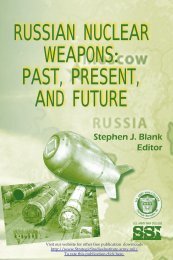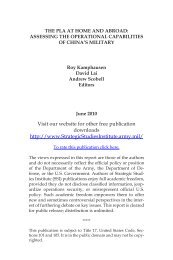The United States and China in Power Transition - Strategic Studies ...
The United States and China in Power Transition - Strategic Studies ...
The United States and China in Power Transition - Strategic Studies ...
You also want an ePaper? Increase the reach of your titles
YUMPU automatically turns print PDFs into web optimized ePapers that Google loves.
co<strong>in</strong>cidence of <strong>in</strong>terests is a matter of convenience. But<br />
“[r]elationships built on shared <strong>in</strong>terest <strong>and</strong> values are<br />
deep <strong>and</strong> last<strong>in</strong>g. We can cooperate with the emerg<strong>in</strong>g<br />
<strong>Ch<strong>in</strong>a</strong> of today, even as we work for the democratic<br />
<strong>Ch<strong>in</strong>a</strong> of tomorrow.” 61 <strong>Ch<strong>in</strong>a</strong>’s peaceful rise would be<br />
possible only with its genu<strong>in</strong>e <strong>in</strong>ternal transformation<br />
<strong>and</strong> external cooperation.<br />
<strong>The</strong> Ch<strong>in</strong>ese took the U.S. response with much<br />
caution. On the one h<strong>and</strong>, they believed that it was<br />
a reluctant acceptance of <strong>Ch<strong>in</strong>a</strong>’s grow<strong>in</strong>g power <strong>and</strong><br />
<strong>in</strong>ternational <strong>in</strong>fluence. On the other, the Ch<strong>in</strong>ese saw<br />
that the “responsible stakeholder” designation had<br />
many hidden agendas <strong>and</strong> trapp<strong>in</strong>gs aga<strong>in</strong>st <strong>Ch<strong>in</strong>a</strong>.<br />
First, it was a U.S. hegemonic design to <strong>in</strong>corporate<br />
<strong>Ch<strong>in</strong>a</strong> <strong>in</strong>to the U.S. “orbit.” <strong>The</strong> <strong>United</strong> <strong>States</strong> would<br />
expect <strong>Ch<strong>in</strong>a</strong> to follow the rules set by the <strong>United</strong><br />
<strong>States</strong> <strong>and</strong> the West. <strong>The</strong> latter would be the judge<br />
for <strong>Ch<strong>in</strong>a</strong>’s acts. Second, the range of responsibilities<br />
would be beyond <strong>Ch<strong>in</strong>a</strong>’s ability. Third, it was an attempt<br />
to get <strong>Ch<strong>in</strong>a</strong> to share the U.S. hegemonic burdens,<br />
many of which were aga<strong>in</strong>st <strong>Ch<strong>in</strong>a</strong>’s moral pr<strong>in</strong>ciples<br />
<strong>and</strong> national <strong>in</strong>terests. Fourth, it was a different<br />
way to blame <strong>Ch<strong>in</strong>a</strong> for those <strong>Ch<strong>in</strong>a</strong>-threat problems<br />
such as ris<strong>in</strong>g costs for energy <strong>and</strong> other national resources,<br />
environmental degradation, climate change,<br />
<strong>and</strong> many others, <strong>and</strong> asked <strong>Ch<strong>in</strong>a</strong> to bear more responsibility<br />
for those global problems. 62<br />
Ch<strong>in</strong>ese analysts nevertheless noted the positive<br />
side of the U.S. response—it was one that sought cooperation<br />
rather than confrontation. However, they all<br />
called for the Ch<strong>in</strong>ese leaders to st<strong>and</strong> firm on <strong>Ch<strong>in</strong>a</strong>’s<br />
long-held <strong>in</strong>dependent foreign policy, take on responsibilities<br />
accord<strong>in</strong>g to <strong>Ch<strong>in</strong>a</strong>’s ability, moral pr<strong>in</strong>ciples,<br />
<strong>and</strong> national <strong>in</strong>terests, even if they were <strong>in</strong> conflict<br />
with those of the <strong>United</strong> <strong>States</strong> <strong>and</strong> the West. <strong>Ch<strong>in</strong>a</strong><br />
62

















